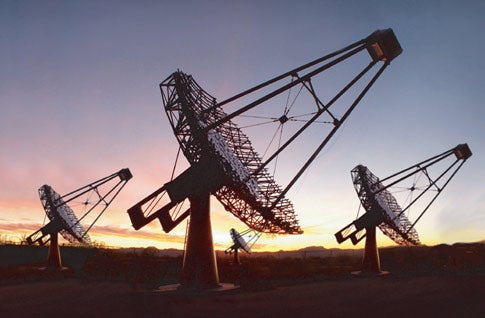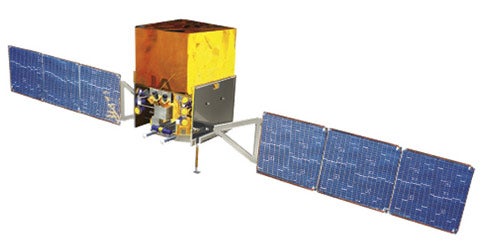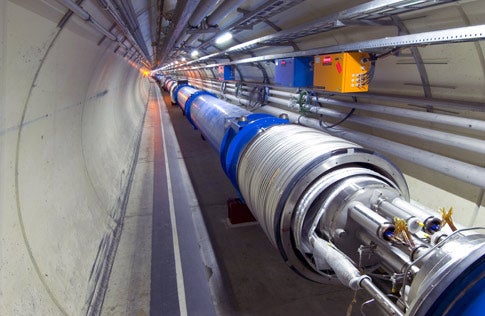The year 2007 will be huge for particle astrophysics. With a ground-based telescope array going online, a gamma-ray satellite launching, and a long-awaited particle accelerator starting up, 2007 should see big news stories.
The Very Energetic Radiation Imaging Telescope Array (VERITAS)
- Ground-based array of four 39-foot-diameter (12 meters) optical telescopes in Arizona.
- All four telescopes scheduled to begin data taking in spring 2007; the first telescope saw first light February 2005.
- VERITAS will observe energies between 50 billion electron volts and 12 trillion electron volts.
- VERITAS is an atmospheric Cerenkov radiation imaging system. When gamma rays strike the atmosphere, they produce secondary radiation — brief flashes of blue light that can be detected only under clear skies at a dark site. This is why southeastern Arizona is a great site for VERITAS.
- VERITAS is the successor to the Whipple Telescope, a 34-foot (10m) instrument. Scientists are building VERITAS atop Mt. Hopkins, next to the Whipple Telescope, but the plan is to move the array to Kitt Peak National Observatory, outside Tucson, once it’s complete.
The Gamma Ray Large Area Space Telescope (GLAST)
- Space-based satellite.
- Scheduled for a September 2007 launch.
- GLAST is the successor to the Compton Gamma Ray Observatory from the 1990s, and will look at energies 10 times higher than Compton did. GLAST’s range is from 10,000 to 300 billion electron volts (the human eye can see energies around 2 electron volts).
- GLAST’s projected lifetime is 5 years, with a goal of 10 years of operations. Project scientists intend to begin with a 1-year all-sky survey of gamma-ray sources. Then they will focus on selected projects from scientists, interrupted by certain “objects of interests,” such as gamma-ray bursts (GRBs).
- GLAST will remain in a low circular orbit at roughly 340miles (550 kilometers) in altitude.
- The primary instrument is the Large Area Telescope (LAT). It’s composed of layers of detecting and converting material. When an incoming gamma ray interacts with the converting material, the gamma ray changes into an electron and a positron. These particles travel through further layers, creating more gamma rays and electron-positron pairs. The detectors then tell scientists the initial gamma ray’s energy and direction.
- The other instrument aboard GLAST is the GLAST Burst Monitor (GBM). It will study GRBs, and further the findings of NASA’s Swift satellite.
The Large Hadron Collider (LHC) at CERN
- The LHC is a particle accelerator on the border of Switzerland and France.
- It will be the most powerful accelerator when it begins operations; the first collisions are scheduled for November 2007.
- LHC will collide beams of protons ultimately at energies of 14 trillion electron volts.
- The LHC is a giant accelerator ring with a 16.8-mile (27 kilometers) circumference, which enables the particles to reach these extreme energies.
- LHC data will give scientists insight into the four fundamental forces, discover new particles, and answer questions about antimatter. The LHC may also unlock a few secrets of the universe: the nature of dark matter and possibly proof of string theory.













